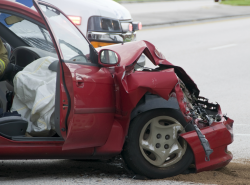
— Expect to see automatic emergency braking (AEB) technology become a standard feature on new vehicles as 10 automakers have committed to making the technology as routine as windshield wipers on a car.
The U.S. National Highway Traffic Safety Administration and the Insurance Institute for Highway Safety (IIHS) announced the agreement with Audi, BMW, Ford, General Motors, Mazda, Mercedes-Benz, Tesla, Toyota, Volkswagen and Volvo.
Automatic emergency braking is part of a host of security measures that fall under the category of forward collision avoidance systems. Some systems provide a warning if a car is approaching an object in the road, but the driver is responsible for avoiding the object.
With AEB systems, a driver receives a warning in the event of an imminent forward crash. If the driver doesn't take action, the computer will intervene and apply the brakes without the driver doing anything.
The systems are created using radar, cameras or lasers to detect a crash that is about to occur. Because most rear-end collisions are caused by driver error, automatic braking systems can compensate for driver mistakes.
An AEB system might combine electronic stability control with driver assist systems to slow down a vehicle before a collision, avoiding an impact or making the impact far less severe. A typical system will combine incoming data from forward-looking video and radar systems to give the computer a real-time image of the road. Once activated, brake pressure is applied without a driver touching the pedal, but once the pedal is pushed, maximum brake boost is engaged.
In its most extreme situation, the automatic emergency braking will apply maximum brake pressure on its own if what a driver is doing isn't enough.
AEB systems have typically been available only as an added option for car buyers or as a standard feature on more expensive cars. As for safety benefits, IIHS says studies have confirmed the advantages of AEB systems by showing the technology can reduce insurance injury claims by up to 35 percent.
Research from outside the U.S. has also confirmed the benefits of autobrake technology. Research conducted by the Australian New Car Assessment Program and European New Car Assessment Programme showed automatic braking systems resulted in 38 percent fewer rear-end collisions in Australia and Europe.
A timeline hasn't been set for when the AEB systems will be offered as a standard feature by the 10 automakers, but once active, it's expected that 57 percent of new light-duty vehicles will be equipped with the technology. That number would be greatly increased except for the fact Fiat Chrysler, Honda and Nissan didn't sign off on the agreement.
Although the technology won't fall asleep at the wheel like we tired humans, forward collision systems can still malfunction based on simple software errors.
In June 2015, the government opened an investigation into the 2014 Jeep Grand Cherokee after complaints alleging the autonomous braking system could be activated without warning while driving. Owners of the 2014 Jeep Grand Cherokee complained the system activated on its own, warned the driver of an imminent crash and then slamed on the brakes.
Then in May 2015, the 2014-2015 Acura MDX and RLX were recalled because the emergency braking system could malfunction when the car went near metal such as a guard rail or fence. Once the Acura sensed a frontal impact was about to occur, the emergency braking system would activate on its own without warning and cause all kinds of trouble with traffic behind the car.




